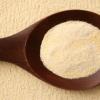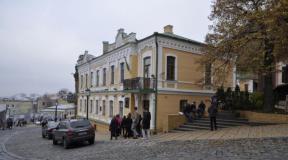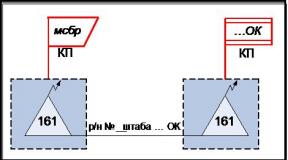Roald Amundsen and Robert Scott: South Pole. Roald Amundsen and Robert Scott American Antarctic Station
Amundsen-Scott Station, named after the discoverers of the South Pole, is striking in its scope and technology. The complex of buildings, around which for thousands of kilometers there is nothing but ice, is downright its own separate world. We were not told all the scientific and research secrets, but we had an interesting excursion around the residential blocks and showed how the polar explorers live ...

Initially, during construction, the station was located exactly at the geographic south pole, however, due to the movement of ice over several years, the base shifted to the side by 200 meters:
3.
This is our DC-3 plane. In fact, it has been heavily modified by Basler and almost all the hardware in it, including avionics and engines, is new:
4.
The plane can land both on the ground and on the ice:
5.
This photo clearly shows how close the station is to the historic South Pole (a group of flags in the center). And the lone checkbox on the right is the geographic South Pole:
6.
Upon arrival, we were met by an employee of the station and gave us a tour of the main building:
7.
It stands on stilts, as do many houses in the north. This is done so that the building does not melt the ice under it and does not "float". In addition, the space below is perfectly blown by the winds (in particular, the snow under the station has not been cleaned even once since its construction):
8.
Station entrance: you need to climb the stairs two flights. Due to the thinness of the air, this is not easy to do:
9.
Residential blocks:
10.
At the pole, during our visit, it was -25 degrees. We arrived in full uniform - three layers of clothing, hats, balaclavas, etc. - and then we were suddenly met by a guy in a light sweater and crocs. He said that he was used to it: he had already survived several winters and the maximum frost that he found here - minus 73 degrees. For about forty minutes, while we walked around the station, he walked around in this form:
11.
The station inside is simply amazing. To begin with, it has a huge gym. Popular games among employees are basketball and badminton. The station uses 10,000 gallons of jet fuel per week to heat the station:
12.
Some statistics: 170 people live and work at the station, 50 people stay in winter. They are fed free of charge in the local canteen. They work 6 days a week, 9 hours a day. Everybody has a day off on Sunday. The cooks also have a day off and everyone usually eats what is left unfinished in the refrigerator since Saturday:
13.
There is a music room (in the title photo), and in addition to a sports room, there is a gym:
14.
There is a room for trainings, conferences and similar events. When we passed by, there was a Spanish lesson:
15.
The station is two-story. A long corridor runs through it on each floor. Residential blocks go to the right, scientific and research blocks to the left:
16.
Conference hall:
17.
Nearby there is a balcony with a view of the outbuildings of the station:
18.
Everything that can be stored in unheated rooms lies in these hangars:
19.
This is the Ice cube neutrino observatory, which scientists use to catch neutrinos from space. In a nutshell, it goes like this: the collision of a neutrino and an atom produces particles known as muons and a burst of blue light called Vavilov-Cherenkov radiation. In transparent arctic ice IceCube optical sensors will be able to recognize it. Usually for neutrino observatories they dig a mine at depth and fill it with water, but the Americans decided not to waste time on trifles and built an Ice cube at the South Pole, where there is plenty of ice. The size of the observatory is 1 cubic kilometer, hence the name. Project cost - $ 270 million:
20.
The theme "made a bow" on the balcony overlooking our plane:
21.
All over the base there are invitations to seminars and master classes. For example, here's a writing workshop:
22.
I noticed garlands-palm trees attached to the ceiling. Apparently the longing for summer and warmth takes place among the employees:
23.
Old station sign. Amundsen and Scott are two pole discoverers who conquered the South Pole almost simultaneously (well, if you look in historical context) with a difference of a month:
24.
There was another station in front of this station, it was called "Dome". in 2010 it was finally dismantled and this photograph captures the last day:
25.
Lounge: billiards, darts, books and magazines:
26.
Scientific laboratory. They didn’t let us in, but they opened the door. Pay attention to the trash cans: separate waste collection is practiced at the station:
27.
Compartments for firefighters. The standard American system: each has his own wardrobe, in front of him is a completely ready-made uniform:
28.
You just need to run up, jump into your shoes and put on:
29.
Computer Club. Probably, when the station was being built, it was relevant, but now everyone has laptops and they come here, I think, to cut themselves into a toy over the network. There is no wifi at the station, but there is a personal Internet access at a speed of 10 kb per second. Unfortunately, they didn’t give it to us, and I didn’t manage to check-in at the pole:
30.
Just like at ANI camp, water is the most expensive pleasure at the station. For example, it costs a dollar and a half to flush the toilet:
31.
Medical Center:
32.
I looked up and looked at how perfectly the wires were laid. Not as it happens with us, and even more so somewhere in Asia:
33.
The station is home to the most expensive and most difficult to access gift shop in the world. A year ago, Eugene Kaspersky was here, and he had no cash (he wanted to pay with a card). When I went, Zhenya gave a thousand dollars and asked to buy everything that was in the store. I, of course, stuffed my bag with souvenirs, after which my fellow travelers began to hate me quietly, as I created a queue for half an hour.
By the way, in this store you can buy beer and soda, but they only sell them to station employees:
34.
There is a table with South Pole seals. We all took our passports and stamped:
35.
The station even has its own greenhouse and greenhouse. Now they are not needed, since there is a communication with the outside world. And in winter, when communication with the outside world is interrupted for several months, employees grow their own vegetables and herbs:
36.
Each employee has the right to use the laundry once a week. You can take a shower 2 times a week for 2 minutes, that is, 4 minutes a week. I was told that usually everyone saves and bathes every two weeks. Honestly, I already guessed by the smell:
37.
Library:
38.
39.
And this is a corner of creativity. It has everything you can imagine: sewing thread, paper and paint for painting, prefabricated models, cardboard, etc. Now I really want to get to some of our polar stations and compare their life and facilities:
40.
There is a stick at the historic South Pole that has not changed since the days of the discoverers. And the geographic South Pole marker is moved every year to compensate for ice movement. The station has a small museum of knobs accumulated over the years:
41.
In the next post I will talk about the South Pole itself. Stay Tuned!
History and present
The station is located at an altitude of 2835 above sea level, on a glacier, which nearby reaches a maximum thickness of 2850 m (). The average annual temperature is about -49 ° С; ranges from −28 ° C in December to −60 ° C in July. Average wind speed - 5.5 m / s; gusts up to 27 m / s were recorded.
Foundation of the station (1957-1975)
The original station - now called the "Old Pole" (eng. Old pole) - was founded in 1956-1957. by a US Navy expedition of 18 people, who landed here in October 1956 and for the first time in the history of Antarctica spent the winter there in 1957. Since the climatic conditions were not previously known, the base was built underground to cope with any worst weather conditions. The lowest temperature in 1957 was recorded at −74 ° C (−102 ° F). Surviving such a low temperature, combined with low humidity and low air pressure, is only possible with proper protection.
The station, abandoned in 1975, is covered with snow (like any structure at the South Pole) at a rate of 60-80 mm per year. Now she is buried deep enough and completely closed for visits, as the snow crushed all the wooden floors.
On January 4, 1958, the Trans-Antarctic Expedition of the British Commonwealth arrived at the station with the famous climber Edmund Hillary. This was the first expedition to use automobile transport, and the first to reach the Pole by land, after Amundsen in 1911 and Scott in 1912. The expedition moved from the Scott Base station in New Zealand.
Dome (1975-2003)

Aerial photograph of Amundsen-Scott Station circa 1983. The central dome is visible, along with various containers and ancillary structures.

The main entrance to the dome is located below the snow level. The dome was originally built on the surface, but then gradually sank into snow.
The aluminum unheated "tent" is a landmark of the pole. It even had a post office, shop and pub.
Any building on the pole is quickly surrounded by snow and the dome design was not the best. It took a huge amount of fuel to remove the snow, and shipping a liter of fuel costs $ 7.
The 1975 equipment is completely outdated.
New scientific complex (since 2003)
The unique design on piles allows snow to pass underneath the building rather than accumulate near the building. The sloping shape of the lower part of the building allows the wind to be directed under the building, which helps to blow out the snow. But sooner or later the snow will cover the piles and then it will be possible to raise the station twice with jacks (this increases the station's service life from 30 to 45 years).
Building materials were delivered by Hercules planes from McMurdo station on the shore and only during daylight hours. More than 1000 flights have been made.
The complex contains:
- 11 km low frequency antenna for observing and predicting celestial and cosmic storms,
- the tallest at the pole 10-meter telescope, which has risen 7 floors up and weighing 275 thousand kg
- drilling rig (depth - up to 2.5 km) to study neutrinos.
On January 15, 2008, in the presence of the leadership of the US National Science Foundation and other organizations, the American flag was lowered from the dome station and raised in front of the new modern complex. The station can accommodate up to 150 people in summer and about 50 in winter.
Activity
In summer, the population of the station is, as a rule, more than 200 people. Most of the personnel leave by mid-February, leaving only a few dozen people (43 in 2009) wintering, mostly support personnel plus a few scientists who maintain the station during several months of the Antarctic night. Winterers are isolated from the rest of the world from mid-February to the end of October, at which time they face many dangers and stresses. The station is completely self-sufficient in winter and is powered by three generators powered by JP-8 aviation fuel.
Research at the station includes sciences such as glaciology, geophysics, meteorology, upper atmosphere physics, astronomy, astrophysics, and biomedical research. Most scientists work in low frequency astronomy; the low temperature and low humidity of the polar air, combined with altitudes of over 2,743 m (9,000 ft), causes the air to be much clearer at some frequencies than usual elsewhere, and months of darkness allow sensitive equipment to operate continuously.
Developments
In 1991, Michael Palin visited the base during the 8th and final episode of his BBC television documentary Pole to Pole.
In 1999, during the winter, doctor Jerry Nielsen discovered she had breast cancer. She had to give herself chemotherapy with medications dropped in July, and then she was taken out after the first plane landed in mid-October.
In January 2007, a group of high-ranking Russian officials visited the station, including the chiefs of the FSB Nikolai Patrushev and Vladimir Pronichev. The expedition, led by polar explorer Artur Chilingarov, took off in Chile on two Mi-8 helicopters and landed at the South Pole.
On September 6, 2007 a TV show went on the air Man made to the National Geographic Channel with an episode about the construction of a new building here.
November 9, 2007 program Today NBC, with co-author Anne Carrie, made a satellite phone report that was broadcast live from the South Pole.
On Christmas Day 2007, two drunken base personnel fought and were evacuated.
In popular culture
The station has featured prominently in a number of science fiction television series, including The X-Files: Fight for the Future.
A station at the South Pole called Snowcap base was the site of the first cyber-human invasion of Earth in the 1966 TV series Doctor Who The tenth planet.
In film White mist(2009) the action takes place at Amundsen-Scott station, although the buildings in the film are completely different from the real ones.
Time zone
At the South Pole, sunset and sunrise are theoretically only visible once a year, at the autumn and spring equinox respectively, but due to atmospheric refraction, the sun stays above the horizon for more than four days each time. There is no solar time here; there is no daily maximum or minimum of the sun's height above the horizon. The station uses New Zealand time (GMT +12 hours or +13 hours in summer) as all flights to McMurdo Station originate from Christchurch and therefore all official travel from the poles passes through New Zealand.
Gallery
New Station and Geographic South Pole
|
New station aerial view, January 2005 |
New station, January 2007 |
Geographic South Pole, old station in the background, 1996 |
“... A black flag tied to a sled runner, nearby - the remains of a camp, traces of sledges and skis going in both directions, clear prints of dog paws ... Then we understood everything. The Norwegians were ahead of us and were the first to reach the pole. This is a terrible disappointment, and I am very sorry for my faithful comrades. We changed our minds a lot, argued a lot among ourselves. Tomorrow we must go further - to the Pole, and then hurry home as fast as we can. The end of all our dreams; the return will be sad ”(entry from the diary of RF Scott, January 18, 1912).
Two attempts by the British to conquer the South Pole - in 1902 and 1909. - turned out to be unsuccessful. Robert Scott managed to advance to latitude 82 ° 17 ', Ernest Shackleton - to 88 ° 23'. By the way, the news that Shackleton, a former participant in Scott's 1902 campaign, was going on an independent expedition, came as an unpleasant surprise for the latter. He wrote several letters to Shackleton, in which he demanded not to use the coast of McMurdo Strait for the establishment of the base, since he considered it his exclusive right. After Shackleton was forced to land there, and did not find anything more or less suitable around, Scott began to consider him his personal enemy. I wonder what Navy Captain Scott would have done if Shackleton had achieved his goal? Recall that just in 1909 a scandal began over the other pole, the North: Robert Peary, having learned that he had lost the competition to Frederick Cook, used all his connections and a lot of money to mix a more successful competitor with mud.

But Shackleton "left the race" 180 km before the finish line, and in 1910 the British government and the Royal Geographical Society equipped another expedition to Antarctica, and Robert Falcon Scott, leading it, got a second chance. At the end of June, the expedition ship "Terra Nova" set sail. There were 65 people on board. Scott took with him 33 sled dogs and 15 small Chinese (and maybe Mongolian or Buryat) horses, as well as two motor sleds. There were a lot of scientific equipment on board, sufficient supplies of fuel, food and warm clothing.
And in September of the same year, the famous "Fram" headed by Roald Amundsen went to the shores of Antarctica. It was a real sensation. Amundsen dreamed of conquering the North Pole and specifically for this he turned to Fridtjof Nansen many times with a request to provide him with this tried-and-true vessel, which also brought good luck. However, Nansen himself was not averse to repeating the attempt to reach the Pole and therefore hesitated, but finally agreed to hand over the Fram to Amundsen. He prepared to sail - across the Atlantic, around Cape Horn, further along the Pacific Ocean to the Bering Strait, and then drift, like Nansen, - along with ice through the central part of the Arctic.
And suddenly on September 9, during the call to Madeira, Amundsen announced to the crew about a change in his plans. Later, he claimed that he made the decision to go to the southernmost point of the planet spontaneously, suddenly learning that the North Pole had already submitted to one of the Americans. In fact, a whole year had passed since the dispatch of the victory telegrams from Cook and Peary - there could be no question of any surprise. Most likely, for some time he was really preparing for a drift in the Arctic Ocean, but nevertheless he made the decision to sail to Antarctica long before September 1910. Hiding his true plans, he gained time, and announcing them, instilled nervousness in Englishmen. Scott received word of Amundsen's plans in October, when the British were in Australia.
Scott's expedition arrived in Antarctica, on the coast of his favorite McMurdo Strait, in January 1911. At about the same time, but to the east, in Whale Bay, cut into the Ross Ice Shelf, the Fram appeared. Almost everyone considered it extremely dangerous to land on the surface of the glacier, especially very close to its edge, which is constantly breaking off. Risk? Undoubtedly. But Amundsen calculated everything. He knew that in the area of Whale Bay the edge of the glacier had been stable for several decades, more precisely, since 1841, when it was discovered by James Clark Ross. At the same time, the Norwegian base was almost 100 km closer to the pole than Scott's camp.
The Fram was quickly unloaded. Instead of resting, Amundsen and several companions immediately set out on a campaign to 80 ° S. NS. There he set up a food warehouse. Along the route, at regular intervals, beacons were installed - poles with flags, and supplies of food for dogs were made. At the end of February, Amundsen led another detachment. This time the warehouses were arranged at 81 ° and 82 ° S. NS. In total, before the onset of the Antarctic winter, 3 tons of food for people and food for dogs were delivered to the warehouses. During the wintering, several strong and light sledges were made, the weight of the boxes was extremely lightweight: the boards were cut to a minimum thickness. The tents were painted black - gloomy, but very noticeable. Amundsen tried to take into account every detail. According to the great Norwegian, victory is brought not by so-called luck, but by careful consideration of all possible difficulties and dangers and, of course, preparedness for them.
It cannot be said that Scott prepared poorly: like the Norwegians, the British did not waste time and made several reconnaissance and preparatory campaigns along the future route. In the Antarctic spring, both squads went to the Pole. But the British left on November 1, and Amundsen on October 20, and the latter's camp was located much closer to the pole. Amundsen took several dozen sled dogs on the way, the British again relied on horsepower. They were just not enough. The unfortunate equids were not at all adapted to moving on ice; by the end of the first half of the distance they all died. By the way, motor sleds turned out to be an even more unreliable means of transportation on the Ice Continent. In general, soon people had to drag the sled up the hill by themselves. At the beginning of January 1912, when about 240 km remained to the target, Scott sent back the last auxiliary detachment, and he himself with four satellites went to the assault. The British reached the South Pole on 17 January, but there was already a tent with a Norwegian flag and a note from Amundsen. The Norwegians came to the Pole on December 14, ahead of their competitors for more than a month, and now they were finishing their way back. For the British, this was a terrible blow, and for the immensely ambitious Scott, it was a real shock.
But I had to go back. At first everything went well: the five moved from warehouse to warehouse, and the temperature did not drop below –30 ° С. However, every day the headwind
became stronger and stronger. And then misfortunes followed in a continuous series. Junior Officer Edgar Evans, a big man and joker, taken by Scott in the assault group despite serious violations of discipline, even at the pole, severely cut his hand, and this had a catastrophic effect on his state of mind. Soon he fell into a crack and received severe bruises, as well as a severe concussion. Evans was rapidly losing strength and died on February 17. It became more and more difficult to walk, the weather deteriorated - winter was beginning. Frost over forty, and a terrible wind, knocking down. Frostbite began; Lawrence Oates, who was no longer able to walk, was particularly badly affected. Once, in one of the intermediate camps, Oates crawled into a blizzard and did not return. Nobody stopped him. It happened on March 17th.
Little remained to the coastal base, but the forces were even less, and food and fuel were running out. On top of all the troubles - a monstrous blizzard, which did not allow even a step to step. Scott's diary is evidence of the gradual fading of hope for salvation. The last entry in it is dated March 29: “From the 21st, a continuous storm raged ... Every day we were ready to walk - only 11 miles to the warehouse - but there was no way to get out of the tent, so the snow was carrying and twisting. I don’t think that we can hope for anything else now ... It's a pity, but I don’t think that I will be able to write. R. Scott ".
Only the next summer, eight months later, the members of the English expedition found Scott's tent, which withstood all the winds. The bodies of Robert Scott, Edward Wilson and Henry Bowers lay in sleeping bags. Scott was the last to die: only his bag was not closed. Next to him they found notebooks, a camera, cassettes with films. Among the items were geological samples.
And what about the winners? The entire route - to the Pole and back, only about 3 thousand km - took Amundsen and his comrades 99 days. On way back the Norwegians were elated in victory, while the British, on the contrary, were crushed by the monstrous weight of defeat. The British walked on foot, and the Norwegians carried the remaining dogs. Amundsen and his comrades managed to go through the entire route before the weather deteriorated, Scott and his companions were caught in winter halfway to the shore. And finally, the same initial handicap - 100 km advantage and an earlier start. These are, perhaps, all the reasons for the victory of some and the defeat of others - remember Amundsen's statement about luck.
Subsequently, many accused Amundsen of abuse with dogs. The fact is that it was impossible to establish warehouses with foodstuffs along the entire route. Amundsen decided to use his dogs not only as a draft force, but also as a source of food (an Eskimo dog gives about 25 kg of meat), which, moreover, does not need to be carried. He calculated when to shoot each dog in order to transform it from a vehicle into food. Is it cruel? Of course - in relation to the dogs, who served people faithfully. And in relation to people? Probably, we should admit that Amundsen was right, who chose the best option - from the point of view of human survival. The Norwegian himself believed that it was this circumstance that became the main factor in reaching the South Pole and a safe return to the coastal base.
For a very long time, the British considered Robert Scott to be the real conqueror of the pole.
FIGURES AND FACTS
main characters
Roald Amundsen, Norwegian polar explorer; Robert Scott, British officer, polar explorer
Other characters
Englishmen E. Evans, L. Oates, E. Wilson, G. Bowers; Norwegians O. Visting, H. Hansen and others.
Time of action
Route
From Whale Bay and the coast of McMurdo Strait, respectively, to the South Pole
Target
Conquest of the southernmost point of the planet
Meaning
Conquest of the South Pole. Ahead of Scott, Amundsen proved that there are no trifles in organizing expeditions.
In December 1911, the famous Norwegian traveler Roald Amundsen was the first to reach the South Pole. In honor of this day, we decided to see how polar explorers live in our time.
Photoblogger Sergei Dolya reports: “The Amundsen-Scott station, named after the discoverers of the South Pole, is striking in its scope and technology. The complex of buildings, around which for thousands of kilometers there is nothing but ice, is downright its own separate world. All scientific and research secrets were not revealed to us, but we had an interesting excursion around the residential blocks and showed how the polar explorers live ... "
Sponsored by the post: Chickenpox: Prevention and Treatment.



3. Initially, during construction, the station was located exactly at the geographic South Pole, but due to the movement of ice for several years, the base has shifted to the side by 200 meters.

4. This is our DC-3 plane. In fact, it has been heavily modified by Basler, and almost all of the hardware in it, including the avionics and engines, is new.

5. The plane can land both on the ground and on the ice.

6. This photo clearly shows how close the station is to the historic South Pole (a group of flags in the center). And the lone checkbox on the right is the geographic South Pole.

8. It stands on stilts, as do many houses in the north. This is done so that the building does not melt the ice under it and does not "float". In addition, the space below is perfectly blown by the winds (in particular, the snow under the station has not been cleaned even once since its construction).

9. Entrance to the station: you need to climb the stairs two flights. Due to the thinness of the air, this is not easy to do.

10. Residential blocks.

11. At the pole during our visit it was -25 degrees. We arrived in full uniform - three layers of clothing, hats, balaclavas, etc. - and then we were suddenly met by a guy in a light sweater and crocs. He said that he was used to it: he had already survived several winters and the maximum frost that he found here was minus 73 degrees. For about forty minutes, while we walked around the station, he walked around in this form.
Liked? Do you want to keep abreast of updates? Subscribe to our page on
The current version of the page has not yet been checked
The current version of the page has not yet been reviewed by experienced contributors and may differ significantly from the one reviewed on July 4, 2019; checks are required.
Amundsen-Scott Antarctic Station; a striped pillar is visible in front of the flags, denoting the earth's axis (January 2006)
Aerial photograph of Amundsen-Scott Station circa 1983. The central dome is visible, along with various containers and ancillary buildings.
The main entrance to the dome is located below the snow level. The dome was originally built on the surface, but then gradually sank into snow.
The aluminum unheated "tent" is a landmark of the pole. It even had a post office, shop and pub.
Any building on the pole is quickly surrounded by snow, and the design of the dome was not very successful. It took a huge amount of fuel to remove the snow, and shipping a liter of fuel costs $ 7.
The unique design on piles allows snow to pass underneath the building rather than accumulate near the building. The sloping shape of the lower part of the building allows the wind to be directed under the building, which helps to blow out the snow. But sooner or later the snow will cover the piles, and then it will be possible to raise the station with jacks twice (this ensures the station's service life from 30 to 45 years).
Construction materials were delivered by Hercules planes from McMurdo station on the shore and only during daylight hours. More than 1000 flights have been made.
On January 15, 2008, in the presence of the leadership of the US National Science Foundation and other organizations, the American flag was lowered from the dome station and raised in front of the new modern complex. The station can accommodate up to 150 people in summer and about 50 in winter.
The minimum temperature at the geographic south pole of the Earth was -82.8 ° C, 6.8 ° C higher than the absolute temperature minimum on the planet and at the Vostok station (it was -89.6 ° C there), by 0.8 ° C lower than the unofficially recorded minimum in 1916 in Oymyakon, the coldest winter city in Russia and the Northern Hemisphere, and was recorded on June 23, 1982, one day after the summer solstice. In this century, the strongest frost in Amundsen-Scott was observed on August 1, 2005, -79.3 ° C.
In summer, the population of the station is, as a rule, more than 200 people. Most of the personnel leave by mid-February, leaving only a few dozen people (43 in 2009) wintering, mostly support personnel plus a few scientists who maintain the station during several months of the Antarctic night. Winterers are isolated from the rest of the world from mid-February to the end of October, at which time they face many dangers and stresses. The station is completely self-sufficient in winter and is powered by three generators powered by JP-8 aviation fuel.
Research at the station includes sciences such as glaciology, geophysics, meteorology, upper atmosphere physics, astronomy, astrophysics, and biomedical research. Most scientists work in low frequency astronomy; the low temperature and low humidity of the polar air, combined with elevations of over 2,743 m (9,000 ft), provide much greater air transparency at some frequencies than is usual elsewhere on the planet, and months of darkness allow sensitive equipment to operate continuously.
In January 2007, a group of high-ranking Russian officials visited the station, including the chiefs of the FSB Nikolai Patrushev and Vladimir Pronichev. The expedition, led by polar explorer Artur Chilingarov, took off in Chile on two Mi-8 helicopters and landed at the South Pole.
On September 6, 2007 a TV show went on the air Man made to the National Geographic Channel with an episode about the construction of a new building here.
November 9, 2007 program Today NBC, with co-author Anne Carrie, made a satellite phone report that was broadcast live from the South Pole.
On Christmas Day 2007, two drunken base personnel fought and were evacuated.
Every year, the station staff gathers to watch films "






















